Satellite Basics
Guide To Satellite-based Solutions
Satellites provide today's businesses with a flexible, universal, reliable and quickly deployable means to address a wide range of communications needs. Use this guide to find out why and how companies from a variety of industries use satellite-based solutions to advance their businesses.
- How do satellites deliver vital communications around the world?
- What are the key benefits of satellites?
- What is a communications satellite and how does it work?
- What are the different kinds of orbits?
- Geosynchronous Orbit (GEO): 35,786 km above the earth
- Medium Earth Orbit (MEO): 8,000-20,000 km above the earth
- Low Earth Orbit (LEO): 500-2,000 km above the earth
- GEO vs. MEO vs. LEO
- Satellite architecture
- Orbital location and footprint
- Frequency bands and beams
- What is installed on the ground?
- Network topologies
Satellite Basics
Guide To Satellite-based Solutions
1. Benefits of satellite communications
A. How do satellites deliver vital communications around the world?
Because of their universal and multi-point nature, satellite-based solutions can provide a flexible and cost-effective answer to support:
- Fixed or wireless voice and data communications
- Enterprise networking
- Financial transactions
- Internet linkages
- Satellite video transmission and distribution networks
In every case, Intelsat solutions provide for the delivery of vital information, news, sports and entertainment to every corner of the globe, no matter how remote.
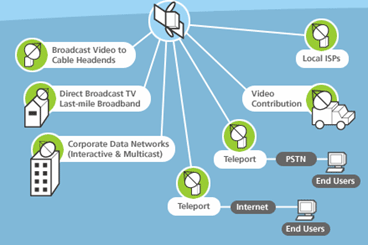
B: What are the key benefits of satellites?
Satellite communications have distinct benefits over terrestrial alternatives:
- UNIVERSAL: Satellite communications are available virtually everywhere. A small constellation of satellites can cover the Earth's entire surface. And even the reach of a single satellite is far more extensive than what any terrestrial network can achieve.
- VERSATILE: Satellites can support all of today's communications needs - transactional and multimedia applications, video, voice, cellular networks, entertainment and breaking news.
- Bring broadband to the last mile of residences and businesses.
- Overcome regulatory issues that make alternative carriers dependent on incumbents.
- Deliver a communications infrastructure to areas where terrestrial alternatives are unavailable, unreliable or simply too expensive.
- RELIABLE: Satellite is a proven medium for supporting a company's communications needs. Whereas terrestrial IP networks are often a mix of different networks and topologies, with different level of congestion and latency. Satellite networks are extremely predictable allowing constant and uniform quality of service to hundreds of locations, regardless of geography.
- SEAMLESS: Satellite's inherent strength as a broadcast medium makes it ideal for the simultaneous distribution of bandwidth-intensive information to hundreds or thousands of locations.
- FAST: Unlike most terrestrial alternatives, satellite networks can be rolled out quickly and inexpensively to hundreds or thousands of locations, connecting cities or remote locations across a large landmass, where copper or fiber is cost prohibitive. Since satellite networks can be set up quickly, companies can be fast-to-market with new services.
- EXPANDABLE: Satellite networks are easily scalable, allowing users to expand their communications networks and their available bandwidth easily. In coordination with local vendors, expanding a network on the ground requires the ordering of new terminal components and the commissioning of increased bandwidth at each site.
- FLEXIBLE: Satellites can be easily integrated to complement, augment or extend any communications network, helping overcome geographical barriers, terrestrial network limitations and other constraining infrastructure issues.
+ How satellite communications work
Satellite Basics
Guide To Satellite-based Solutions
+ Benefits of satellite communications
2. How satellite communications work
A. What is a communications satellite and how does it work?
A communications satellite is a radio relay station in orbit above the earth that receives, amplifies, and redirects analog and digital signals carried on a specific radio frequency.
In addition to communications satellites, there are other types of satellites:
- Weather satellites: These satellites provide meteorologists with scientific data to predict weather conditions and are equipped with advanced instruments
- Earth observation satellites: These satellites allow scientists to gather valuable data about the earth's ecosystem
- Navigation satellites: Using GPS technology these satellites are able to provide a person's exact location on Earth to within a few meters
B. What are the different kinds of orbits?
An orbit is the path that a satellite follows as it revolves around Earth. In terms of commercial satellites, there are three main categories of orbits:
Geosynchronous Orbit (GEO): 35,786 km above the earth
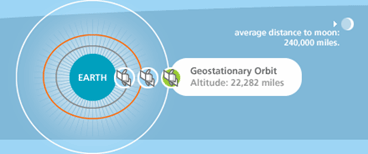
- Orbiting at the height of 22,282 miles above the equator (35,786 km), the satellite travels in the same direction and at the same speed as the Earth's rotation on its axis, taking 24 hours to complete a full trip around the globe. Thus, as long as a satellite is positioned over the equator in an assigned orbital location, it will appear to be "stationary" with respect to a specific location on the Earth.
- A single geostationary satellite can view approximately one third of the Earth's surface. If three satellites are placed at the proper longitude, the height of this orbit allows almost all of the Earth's surface to be covered by the satellites.
Medium Earth Orbit (MEO): 8,000-20,000 km above the earth
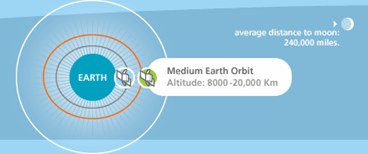
- These orbits are primarily reserved for communications satellites that cover the North and South Pole
- Unlike the circular orbit of the geostationary satellites, MEO's are placed in an elliptical (oval-shaped) orbit
Low Earth Orbit (LEO): 500-2,000 km above the earth
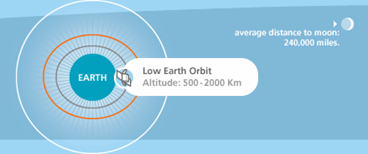
- These orbits are much closer to the Earth, requiring satellites to travel at a very high speed in order to avoid being pulled out of orbit by Earth's gravity
- At LEO, a satellite can circle the Earth in approximately one and a half hours
GEO vs. MEO vs. LEO
Most communications satellites in use today for commercial purposes are placed in the geostationary orbit, because of the following advantages:
- One satellite can cover almost 1/3 of Earth's surface, offering a reach far more extensive than what any terrestrial network can achieve
- Communications require the use of fixed antennas. Since geosynchronous satellites remain stationary over the same orbital location, users can point their satellite dishes in the right direction, without costly tracking activities, making communications reliable and secure
- GEO satellites are proven, reliable and secure - with a lifespan of 10-15 years
For a more comprehensive understanding of satellite advantages, see benefits of satellite.
C. Satellite architecture
Communications data passes through a satellite using a signal path known as a transponder. Typically satellites have between 24 and 72 transponders. A single transponder is capable of handling up to 155 million bits of information per second. With this immense capacity, today's communication satellites are an ideal medium for transmitting and receiving almost any kind of content - from simple voice or data to the most complex and bandwidth-intensive video, audio and Internet content.
Diagrammatic Representation of a Satellite
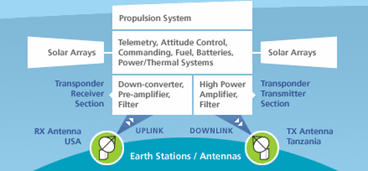
D. Orbital location and footprint
The location of a geostationary satellite is referred to as its orbital location., International satellites, are normally measured in terms of longitudinal degrees East (° E) from the Prime Meridian of 01 (for example, Intelsat satellite 805 is currently located at 304.5° E).
The geographic area of the Earth's surface over which a satellite can transmit to, or receive from, is called the satellite's "footprint." The footprint can be tailored to include beams with different frequencies and power levels.
E. Frequency bands and beams
Satellites transmit information within radio frequency bands. The frequency bands most used by satellite communications companies are called C-band and the higher Ku-band. Over the next several years, the use of a higher frequency band known as Ka-band is expected to increase. Modern satellites are designed to focus on different ranges of frequency bands and different power levels at particular geographic areas. These focus areas are called beams. Intelsat offers four beam types:
- Global: covering almost 1/3 of Earth's surface
- Hemi: covering almost 1/6 of Earth's surface
- Zone: covering a large landmass area
- Spot: covering a specific geographic area
F. What is installed on the ground?
All communications with a geostationary satellite require using an earth station or antenna. Earth Stations may be either fixed (installed at a specific location) or mobile for uses such as Satellite News Gathering (SNG) or maritime applications. Antennas range in size, from large telecommunications carrier dishes of 4.5 to 15 meters in diameter, to VSAT antennas which can be as small as under one meter, designed to support services such as Direct to Home TV (DTH) and rural telephony.
The antenna, itself, will generally be connected to equipment indoors called an indoor unit (IDU), which then connects either to the actual communications devices being used, to a Local Area Network (LAN), or to additional terrestrial network infrastructure.
G. Network topologies
Depending on the application, satellites can be used with different ground network designs or network topologies. At its simplest, satellite can support one-direction or two-direction links between two earth stations (called respectively simplex transmission and duplex transmission). More complex communications needs can also be addressed with more sophisticated network topologies, such as star and mesh.
The following examples show some of the options available to customers for configuring their satellite networks:
Simplex Transmission
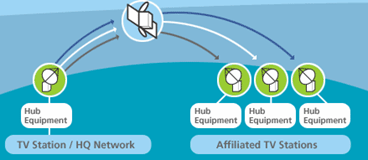
Applications for simplex services include broadcast transmissions such as:
- TV and video services
- Radio services
Point-to-Point Duplex Transmission
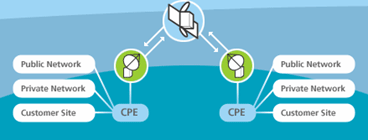
Applications for duplex services include:
- Voice Telephony transport
- Data and IP transport (especially in asymmetric configurations)
- Corporate networks
- TV and Broadcast program contribution and distribution
Point-to-Multipoint Transmission
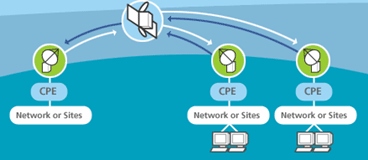
(May be simplex or duplex, symmetric or asymmetric).
Applications for point-to-multipoint services include:
- Corporate networks, including VSAT services and business television
- Video and broadcast distribution, including Direct-to-Home Internet services
Mobile Antenna Service

Applications for mobile antenna services include:
- Satellite News Gathering
- Special Event Backhaul and Broadcasting
- Maritime services
Star Network
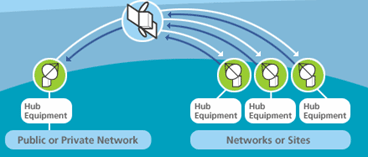
Applications for Star Networks include:
- Corporate Networks
- Distance Learning
Mesh Network
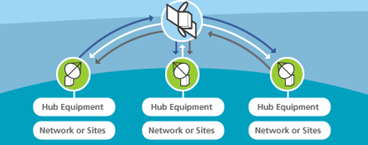
Applications for Mesh Networks include:
- National and International Telephony and Data networks
- Rural Telephony
+ key factors to think about
Satellite Basics
Guide To Satellite-based Solutions
+ How satellite communications work
3. Key factors in considering a satellite solution
Every satellite network is unique and the right choice depends on three key factors:
- The specific application
- The geography of the network
- The volume of traffic required
Intelsat can assist you in determining the best possible customized answer for your organization's networking and communications needs.
If you are ready to speak with an Intelsat sales representative, please feel free to contact us for further assistance or call us at +1 202-944-6800.